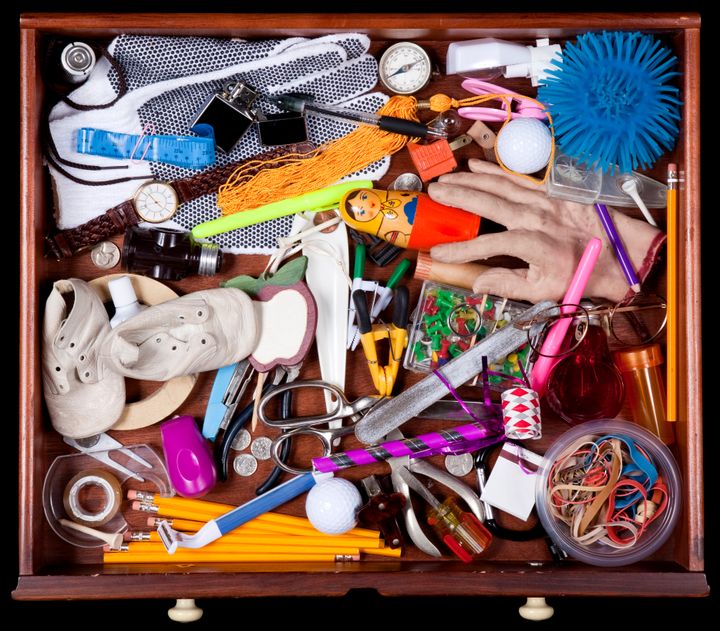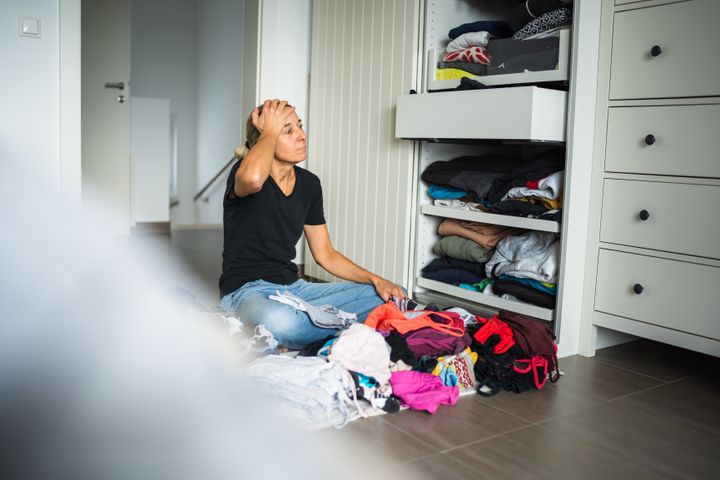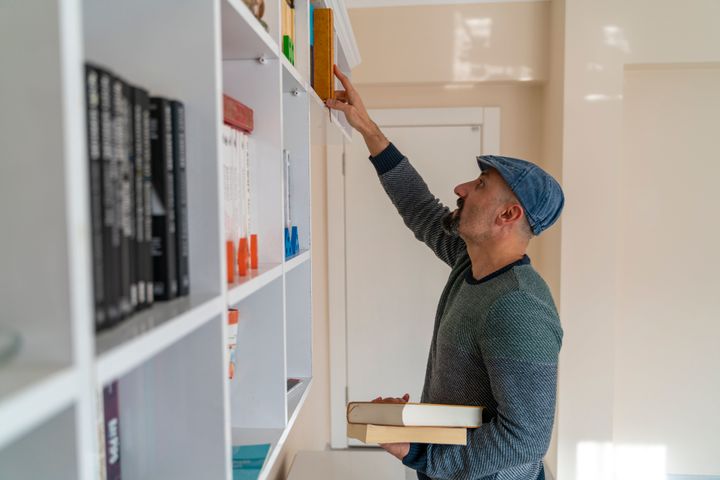
Last summer, a term went viral on TikTok that spoke to many: the DOOM pile.
An acronym for “didn’t organize, only moved,” a DOOM pile could be a junk drawer with receipts, bills and other papers you’ve put off sorting. It could be a cardboard box in the corner of your bedroom full of desk clutter from your old job and other things you forgot you owned.
For many with ADHD ― or others who stare down DOOM piles and feel overwhelmed ― it’s easy to default to a less-than-ideal solution to all that organizational chaos: tossing. Yep, just throwing it all away, with fingers crossed there’s nothing too important in there.
Cate Osborn, an author and ADHD advocate and educator, has tossed her DOOM pile and said she knows plenty of others in the ADHD community who’ve done the same thing.
“It’s not something that I would brag about or say that I’m particularly proud of, but I do know what it’s like to be so completely overwhelmed that it’s easier to say ‘you know what, I don’t need any of this’ and just throw everything away.”
Osborn, who’s known online as Catieosaurus and hosts the podcast “Sorry, I Missed This: The Everything Guide to ADHD and Relationships,” gave an example to illustrate: organizing her desk.
Inevitably, there are some items that don’t have an assigned place in her house. She’ll put that bric-a-brac in a box to sort through later on in the day. But then later comes and Osborn has run out of steam and focus.
“I’ll say, ‘OK, I’ll set this bin of stuff aside and go through it later,’ but because I also struggle with task prioritization and management and working memory, I keep forgetting about the box until I see the box, and often when I see the box, I’m in the middle of another task, so it sits for longer,” Osborn explained.
Finally, days, maybe weeks later, she’ll go through the box, only to experience choice paralysis: “What should I keep?” she’ll ask herself. “What if I need it? What if it’s useful later on.”
Just like that, DOOM boxes pile up, until one day, she finally decides to sell the stuff online or, more likely than not ― toss it. (In her case, dropping it off at a local donation center.)

“It absolutely makes sense that a person with ADHD would get overwhelmed and say, ‘I don’t have the time, space or energy to go through this process, I’m just going to toss the entire box and be free of the clutter,’” she said.
Madison Perry, a psychologist and owner of Austin Holistic Psychology, has heard clients talk about tossing. She likens the impulse to closing all of your internet browser tabs at once: It’s a dangerous business, but it feels amazing.
“Similarly, people with ADHD have too many mental tabs open at once,” she said. “They can become overwhelmed and have to find a way to exit out of a tab or two. Throwing something away takes maintaining that item or finding its rightful storage space off of the overwhelming to-do list.”
Of course, you don’t have to have ADHD to be guilty of tossing: Think of the sense of relief you feel when you’re able to hide your pile of laundry and toddler’s toys in a spare closet right before a guest arrives. Voila, your house is clean, at least temporarily.
Unfortunately, sometimes in the process of wholesale trash tossing, you accidentally throw away important items (like crucial mail or documents), as has happened with some of Perry’s clients.
“They were in that much of a rush to declutter,” she said
What’s going on with the impulse to toss among ADHD-ers?
Tossing is directly tied to executive dysfunction, a behavioral symptom that interferes with ADHD-ers’ ability to begin tasks and comprehend what’s required to complete them, explained Oliver Drakeford, a psychotherapist in West Hollywood, California.
“It’s not just impulsive decluttering; for many people with ADHD, it’s an automatic, reactive behavior that helps people avoid feelings of uncertainty, anxiety and overwhelm that arises when the brain is overstimulated by a big pile of clutter or mess,” Drakeford told HuffPost.
Tossing can also be linked with experiential avoidance, which, broadly speaking, are attempts to avoid thoughts, feelings, memories, physical sensations and other internal experiences, even when doing so hurts you in the long run.
“For example, rather than uncertainty and anxiety generated when you look at the pile of letters and bills that have accumulated, you avoid ― hopefully momentarily ― but throwing them all in a draw until you’re ready to look through them one by one,” Drakeford said.

Drakeford sees “tossing” as an attempt to generate those same feelings of tranquility that a blank slate (or tidy room) can bring you. It feels like a win for those with ADHD because it brings instant relief, but the reality is that it’s a Band-Aid over deeper feelings of emotional overload or uncertainty.
“In the long run, tossing doesn’t really help develop distress tolerance for these uncomfortable feelings, nor does it help develop healthier ADHD management skills,” he said.
If you tend to ‘toss,’ here’s how to get a handle on it.
First, give some thought to why you ‘toss’ when you do.
The first step in making meaningful change from a therapeutic perspective is becoming aware of the emotions driving your actions, according to Drakeford.
“If you’re not conscious of feelings like anxiety, uncertainty, or stress, you’re more likely to operate on autopilot and resort to tossing things impulsively,” he said.
By recognizing your emotional state, you create space to address and soothe those feelings ― giving you more options, which may still include tossing, but in a more mindful way, he said.
Don’t be afraid to throw away things that genuinely need to be tossed.
Look, it’s absolutely OK to throw out take-out containers or other food items if they’ve gotten gross or moldy.
“I think as people with ADHD it’s important to try to avoid being wasteful and contributing to piles of plastic in our landfills, but sometimes, taking ownership of our space means making hard choices and having to decide where we draw the line,” Obsorn said. “If being surrounded by moldy dishes is impacting your quality of life, then it may be time to be drastic.”
Try the ’10 Things Game.′
The ADHD brain often assumes it needs to accomplish everything all at once, which leads to stress and anxiety ― exactly the kind of bummer feelings that result in DOOM boxes and then tossing.
To curb this tendency and help cut down large tasks into smaller, manageable ones, give the “10 Things Game” a shot, Drakeford said.
“For example, instead of tackling an entire stack of bills, start by opening just 10,” he said. “Or instead of cleaning the whole kitchen, begin with washing 10 dishes. Completing these small tasks often feels manageable, and if it does, you can always do 10 more.”

Establish a “Two-Minute Rule.”
If a task will take you less than two minutes to complete, do it now, Drakeford said.
“For instance, after breakfast, take two minutes to wash your cereal bowl or put it in the dishwasher right away ― don’t wait until you get home from work, do it now,” he said.
Be kind to yourself.
Osborn said she reads a lot of the comments on ADHD articles and sees so much criticism and hurtful attitudes: Things like “you’re just lazy, you’re just not trying hard enough, just buckle down, you’re immature, what a terrible awful wasteful person.”
What she wants people to understand is that ADHD is a disability of executive function.
“It’s not that we aren’t trying hard enough, it’s not that we’re lazy, it’s that our brains literally process information differently, and those differences really show up in situations like this,” she said.
When you’re talking about ADHD, you’re not talking about a couple of easy steps like “sit down, go through the box, donate,” Osborn explained.
“To the ADHD brain, it’s a series of hundreds of much smaller tasks, all of which are taking energy to process,” she said. “It’s not fun to feel so overwhelmed by a pile of stuff you throw it in the trash. When we do that, it’s because it’s a last resort.”
While you’re working through this, remember to be kind to yourself, Osborn said.
“It’s so easy to feel like a bad person for creating waste or to feel like you are powerless over your space,” she said.
“There are great resources available to help with learning organization strategies ― sites, podcasts ― and it’s really important if you have a kid with ADHD to teach them skills that work with their brains, not against it.”